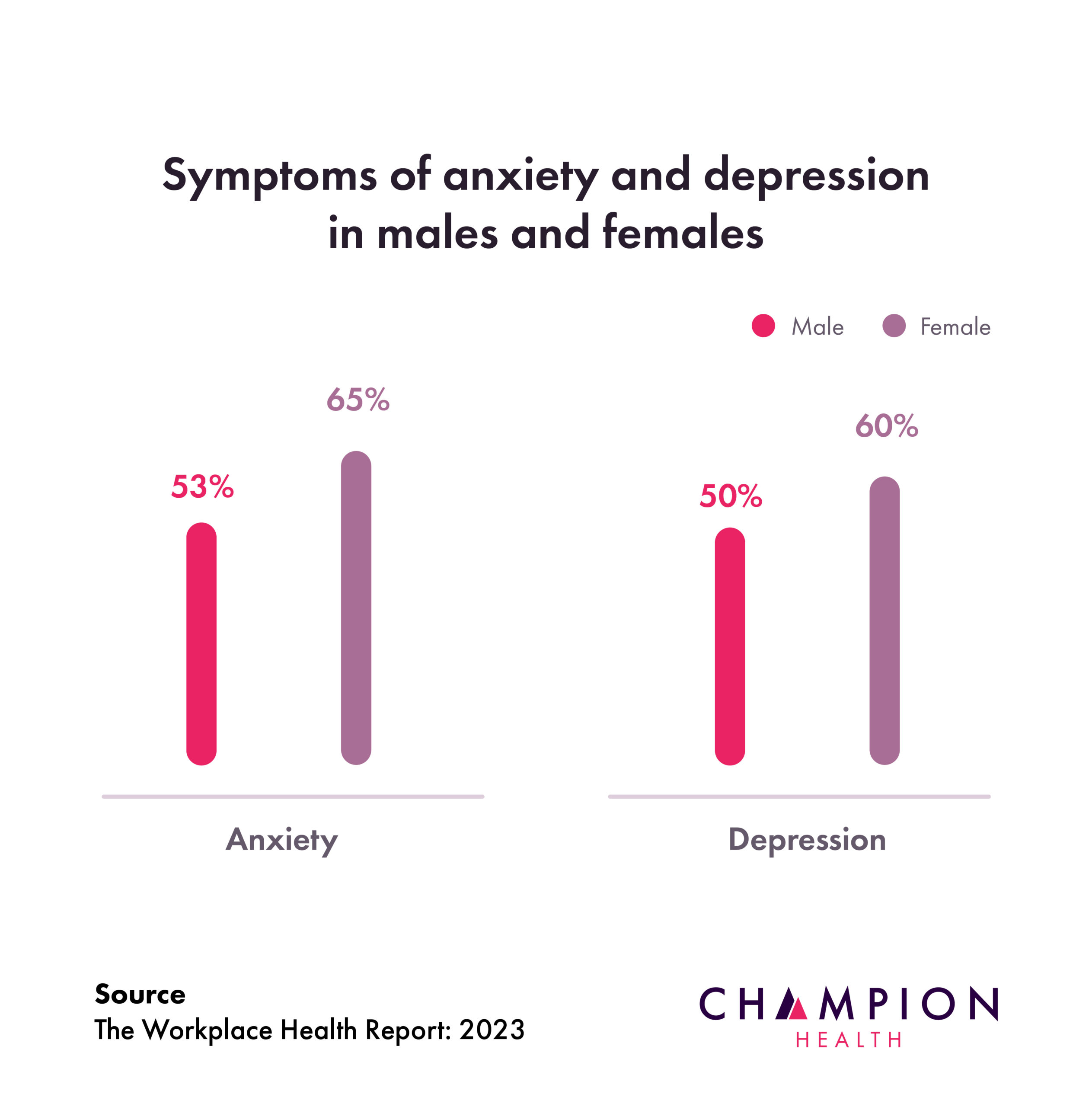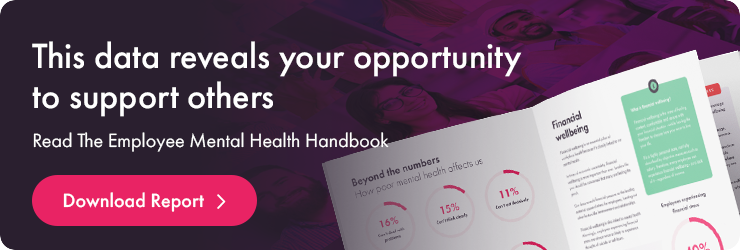We all have mental health, but we all experience it in different ways. So, by educating ourselves through mental health statistics, we can put our own experiences in greater context.
By doing so, you can build your understanding of how mental health affects us all: your friends, family and those you work alongside or manage.
In this article we’ve summarised many of the most up-to-date mental health statistics available and categorised them in the following areas:
This data is derived from reputable online sources and includes our own workplace health data featured in The Workplace Health Report. It is regularly updated to reflect the latest research.
Anxiety
Anxiety is a future-oriented state of mind, characterised by worrying about things that might happen. Perhaps unsurprisingly, there has been an “explosion” in anxiety over the last decade.
Focusing on anxiety, the latest mental health statistics show that:
- Every week in England, 6 in 100 people will be diagnosed with generalised anxiety disorder (Mind)
- In the UK, over 8 million people are experiencing an anxiety disorder at any one time (Mental Health UK)
- Less than 50% of people with generalised anxiety disorder access treatment (Mental Health Foundation)
When it comes to the workplace, we contributed our own data from The Workplace Health Report, which covered the impact of anxiety on UK employees. Our research shows that:
- 60% of employees are experiencing anxiety (Champion Health)
- 65% of female employees are experiencing anxiety (Champion Health)
- 53% of male employees are experiencing anxiety (Champion Health)
- Only 10% of employees are seeking mental health support (Champion Health)
Looking for more? Read this in-depth article covering anxiety statistics.
Depression
Depression can make you feel persistently down or sad for weeks or months at a time. It is one of the most prevalent mental health disorders in the world.
When it comes to mental health statistics focusing on depression, research shows that:
- Around 1 in 6 adults in the UK are experiencing depression (ONS)
- Women are twice as likely to experience depression than men (Streb et al., 2021)
- 15% of women receive treatment for depression, compared to only 9% of men (Mental Health Foundation)
And depression is not just a public health issue. It also presents significant challenges for organisations. Data from The Workplace Health Report shows that:
- 56% of employees are experiencing symptoms of depression (Champion Health)
- 50% of male employees are experiencing symptoms of depression (Champion Health)
- 60% of female employees are experiencing symptoms of depression (Champion Health)

Looking for more? Read this in-depth article covering depression statistics.
Stress
Stress is the body’s reaction to feeling threatened or under pressure and we experience it day-to-day.
Too much stress affects our mood, body and relationships. That’s why it’s crucial that we can gain a clear and data-driven view of how stress affects us.
The latest statistics show that:
- The most common cause of stress is work-related stress, with 79% saying they frequently experience it (Statistica)
- One in 14 UK adults (7%) feel stressed every single day (CIPHR)
- 74% of people feel so stressed they have been overwhelmed or unable to cope (Mental Health Foundation and YouGov)
As the first statistic reveals, when many of us think of stress, we think of the workplace. With that in mind, here are the statistics around how stress affects us at work:
- 76% of employees report moderate to high levels of stress (Champion Health)
- 37% of employees experience negative stress at work (Champion Health)
- 33% report that high levels of stress impact productivity (Champion Health)
- Of those under stress, 73% cite workload as a cause (Champion Health)

Looking for more? Read this in-depth article covering stress statistics.
Suicidal thoughts
According to Samaritans, understanding suicidal thoughts statistics can help us to better target action and prevent suicide.
With that in mind, here are the latest mental health statistics covering suicide and self-harm:
- Over 700,000 people take their own life each year – that’s one person every 40 seconds (World Health Organization)
- 1 in 5 people have suicidal thoughts (NHS Digital)
- 1 in 14 people self-harm (NHS Digital)
These effects permeate into our workplaces. Champion’s Workplace Health Report data shows that:
- 9% of employees are experiencing thoughts of suicide or self-harm (Champion Health)
- Only 25% of employees seeking mental health support are male (Champion Health)
- Employees experiencing financial stress are twice as likely to experience thoughts of suicide or self-harm (Champion Health)
Looking for more? Read this in-depth article covering suicidal thoughts statistics.

And if you’re concerned about a colleague, access these resources for guidance and advice.
Financial wellbeing
Financial wellbeing means feeling content, comfortable and secure with your financial situation – and feeling able to live the life you want to live.
When you do not feel this way about your money, you are at risk of poor financial wellbeing,
As we continue to navigate a cost of living crisis, financial wellbeing is front of mind for many. To help you understand these effects, we’ve compiled the most recent statistics:
- Over 1.5 million people are experiencing both problem debt and mental health problems (Money and Mental Health)
- As many as 24 million adults don’t feel confident managing their money (Money & Pensions Service)
- Only a third of the people in financial debt receive help (Financial Capability Survey)
Research also reveals the strong link between financial wellbeing and mental health. The statistics show that:
- Half of people in problem debt have a mental health problem (Money and Mental Health)
- Almost 40% of people with a mental health problem say it is worsened by their financial situation (Money and Mental Health)
Champion Health explored the prevalence and effects of poor financial wellbeing for employees in our landmark cost of living report. Our data showed:
- 37% of employees cite financial pressure as a cause of stress outside of work (Champion Health)
- Female employees are 33% more likely to experience financial stress (Champion Health)
- 34% of employees experiencing financial stress are aged 25-34 (Champion Health)
Looking for more? Read this in-depth article covering financial wellbeing statistics.
Understanding mental health
By reading this article, you now understand just how common mental health challenges are. And in doing so, you can start to make a difference to the lives of others.
We’re often asked which small change can make a big difference. Here’s what we suggest.
Start by speaking to a friend, colleague or family member and just ask them how they are feeling. After they respond, ask them again. This can help give that person permission to get past the pleasantries and give you a real answer. This is one small change everyone can make.






